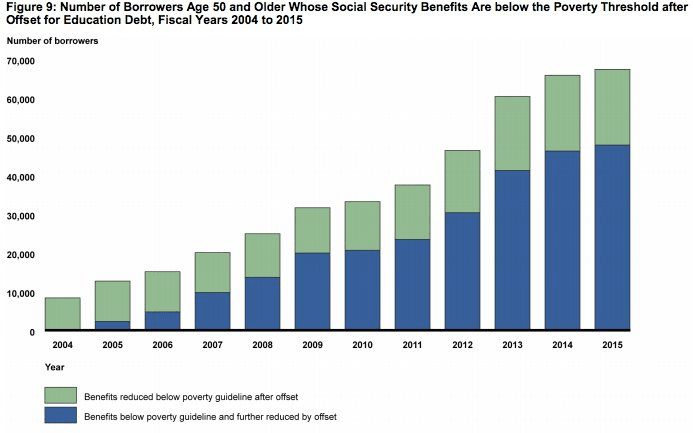It can take years, even decades, for student loan borrowers to repay their debts. To that end, a new report has found that tens of thousands of older adults – including senior citizens – continue to be saddled with mountains of student debt later in life, often having their government benefits cut to repay the costs.
A new report [PDF] from the Government Accountability Office found that tens of thousands of senior Americans currently have their Social Security benefits garnished hundreds of dollars each month by the government in order to repay long-held, defaulted federal student loans.
Under current law, borrowers ages 50 years and older who have defaulted on their student loans are required to repay the debt with a portion of their Social Security benefits.
According to the report, in most cases this translates to about $140, or 15%, of their benefit payment being withheld for each garnishment.

As a result, in 2015 the Department of Education collected $4.5 billion on defaulted student loans, of which $171 million — or about 10% — was collected through Social Security garnishments, also known as offsets.
To make matters worse, the report found that for each time a borrower’s Social Security was offset, they were charged an offset fee of $15. Over the course of a year, borrowers paid $180 in fees.
Additionally, about 71% of the funds collected through offsets were applied to the fees and interest of the loan debt, while just 28% went to the loan balance. As a result, many debtors actually saw their loan balance increase rather than decrease over time.
Because most borrowers remained in default for more than five years after first having their benefits offset and with most borrowers living on a fixed income dependent on their benefits, the report found that after the garnishments thousands of older student debt holders are now living under the poverty level.
In fact, because the Social Security offset threshold has not been adjusted for increases in cost of living, the number of older American who have their benefits offset leading them to live below the poverty level has grown significantly in the last decade.
In 2004, about 8,300 borrowers 50 years or older received benefits below the poverty level. That figure increased to 67,300 in 2015.

While the report found that most borrowers have their benefits garnished for five years, it also notes that some debtors are able to have their debts forgiven because they are severely disabled.
According to the report, one-third of older borrowers were able to pay off their loans or cancel their debt by obtaining relief through a process known as a total and permanent disability (TPD) discharge, which is available to borrowers with a disability that is not expected to improve.
Despite this option, the GAO found that many borrowers are unable to receive discharges because requirements to do so — including the need for annual documentation — are not clearly and prominently stated. If annual documentation to verify income is not submitted, a loan initially approved for a TPD discharge can be reinstated and offsets resume.
As a result of the report, the GAO outlined several recommendations, including eliminating Social Security benefits garnishment to below the federal poverty line, as well as simplifying the paperwork for disabled Americans to discharge their student loan debt.
The GAO report was sent to the Senate Special Committee on Aging as a response to concerns over older borrower garnishments.
“This report shows us that seniors clearly aren’t immune to the student loan crisis — they’re deeply impacted by this issue to the point that it’s leaving many of them in a dire financial situation,” Missouri Sen. Claire McCaskill — who serves on the Committee — said in a statement.
Sen. Elizabeth Warren (MA) echoed McCaskill’s concerns, calling the offsets “predatory and counterproductive.”
This isn’t the first time that older Americans’ student loan debts have garnered concerns.
In 2014, a separate GAO report found student debt continues to plague consumers over the age of 65. About 3% of households – about 706,000 households – headed by those ages 65 years or older carry student loan debt.
Editor's Note: This article originally appeared on Consumerist.
















